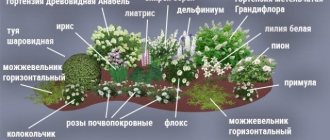In spring, fast-growing flowers are sown. These can be either annuals or perennials. The first ones bloom within 2-3 months. and bloom all season. Perennials are placed immediately in a permanent place. You can understand which flowers are planted in the spring based on the individual characteristics of each species: whimsicality, optimal conditions necessary for their development, flowering time. With the right selection of plants, you can admire continuous flowering from early spring to late autumn.
- Methods for spring planting flowers
- Seedling method
- Seedless method
- Planting separated tubers and rhizomes
- Flowers that are planted in early spring Kochia
- Petunias
- Marigold
- Viola (pansy)
- Snapdragon
- Delphinium
- Kobeya
- morning glory
- Dahlias
- Snowdrops
Seedling method
Of all the options listed, seedlings are the most expensive and time-consuming, but the results are worth it. The advantages of this method are that plants bloom earlier and last longer. There are flowers that can only be grown by seedlings, in particular crops with small seeds: mesembryanthemum, purslane, petunia, mimulus, viola, etc.
Seeds are sown for seedlings from January to April, the specific period depends on the length of the growing season of a particular species. Sowing dates are usually written on bags of seeds.
To grow seedlings, use any universal soil mixture, either forest or garden soil, which is first disinfected from weeds and pests. All seedling containers are also disinfected before use.
Seeds are sown in shallow boxes and covered with film or glass. Germination occurs at a temperature of 20-24°C; they do not need lighting at this stage. From time to time, the crops are watered and ventilated.
When seedlings appear, the box is moved to a bright place; in some cases, additional lamp lighting may be needed. The temperature at this stage of development is 16-18°C.
When the first true leaves appear, the seedlings are planted (dive) into small containers (cups) for better development of the root system. It is planted in open ground when the threat of frost has passed, around mid-May.
Loosestrife
The plant is also called Lily of the Valley loosestrife for its similar root system: these plants have superficial roots and grow very quickly. Therefore, when planting, you need to find a place where the loosestrife cannot crowd out other plants.
This is the only drawback of the loosestrife. Otherwise, the bushy flower does not cause any trouble. The perennial is planted in moist, fertile soil.
The garden is decorated with loosestrife throughout the growing season: in summer - with numerous white inflorescences with a drooping crown, and in spring and autumn - with green and bright yellow decorative leaves.
The lush bush grows up to 1.3 meters in height; The diameter of this unpretentious plant is approximately the same.
Seedless method
Those who want to create a flower garden on their site with a minimum of effort and expense choose the seedless method. I threw the seed into the ground, watered it, it grew, and no problems with the seedlings.
However, only frost-resistant plants can be grown this way. And some crops do not tolerate transplants at all, so they are grown exclusively without seedlings. For example: cosmos, cornflowers, lupine, gypsophila, nasturtium, mignonette and others.
The exact timing of sowing in open ground primarily depends on the local climate and current weather.
The timing is also affected by the length of the growing season. For example, cold-resistant crops with a long growing season are sown early (approximately mid-April). And for heat-loving crops with a short growing season, late sowing is used (from about mid-May to early autumn).
Sow the seeds in soil prepared in advance. Grooves are made for small seeds, and nests are made for large ones. The depth of planting the seed should be equal to the sum of 2-3 of its diameters. And the distance between the seeds is at least 1 cm.
Then the crops are thinned several times. The first time - when the first true leaves appear, 5 cm are left between the seedlings. They are thinned out again 10 days after the first, but the distance is already greater - 10 cm between small plants, 30-40 cm between large ones.
Basilisk
The plant is found in gardens and in the wild. Basil, growing in the wild, was used by our ancestors as a medicinal plant.
Decorative varieties differ in height: some species grow up to 20-25 cm, while others can reach a height of 1.7 meters. Tall species include: columbine basil, Rochenbrunn basil and yellow basil.
Plant the plant in a shady place where the soil is moist and fertile. It is advisable that the plantings be protected from drafts and winds, since strong winds and rain can bend the cornflower to the ground.
Planting separated tubers and rhizomes
Most perennials require periodic division of bushes. This procedure is performed to rejuvenate plants, because Many of them age after a few years and lose their decorative properties. Therefore, you can create a new flower garden from those that you already have growing. It is enough to dig up and divide the old tubers and rhizomes into several parts and plant them again in the ground.
From a financial perspective, this method of spring flower planting may be the most profitable for you. Since there is no need to purchase seeds and spend money on growing seedlings.
You can divide and plant in the spring those perennials that bloom in summer and late autumn. In reference books on this matter, as a rule, there are recommendations for each specific plant.
In order to carefully dig up plants, use a pitchfork, because... a shovel can damage the roots. And also, to preserve the roots, it is better to dig up the bushes with a large lump of earth.
The bushes need to be divided in such a way that each section is approximately the size of a fist, and always includes buds and roots.
Before planting, all wounds and sections of the cuttings are powdered with charcoal to protect against fungal diseases, and left to dry a little (about an hour). The separated tubers and rhizomes are planted at the same depth, but preferably in a new area.
Telekia is beautiful
A tall perennial from the Asteraceae family, native to the Carpathians, the Caucasus and South-Eastern Europe.
Telekia beautiful is a perennial herbaceous plant with a short rhizome. Forms columnar bushes reaching a height of two meters and a width of up to 1 meter. The fragrant leaves are oval-shaped, with a heart-shaped base, up to 30 centimeters long, on petioles 20 centimeters long.
Yellow basket flowers (6-9 cm in diameter) bloom from the second ten days of June.
Beautiful Telekia blooms profusely only when planted in sunny areas with loose, moist, fertile soil. The perennial is propagated by seeds through seedlings (a very long process) and by dividing the bush.
Flowers that are planted in early spring
In order for plants planted at the beginning of the season to bloom in the first half of summer, it is better to first sow them in containers or boxes. And when the snow melts and the earth warms up a little, the seedlings can be transplanted into flower beds. In March you can start breeding:
Kochia
It is sown in a greenhouse or container. Furrows are made in the ground, 1 cm deep. The seeds are placed at intervals of 20 cm. After a month, the kochia can be transferred to open ground.
Petunias
Before planting, the seed material is mixed with sand and not sprinkled with soil after sowing; it is sprayed from a spray gun. When the first leaves appear, the seedlings are moved to separate pots. In April, planting is done in the flower garden. The interval between holes is 25-30 cm. No more than 2-3 petunias are planted in balcony boxes with a volume of 8-10 liters.
Marigold
You can plant it directly into the flowerbed in April-May. They will bloom by the end of June, beginning of July. But in order for them to bloom earlier, they need to be sown at home in containers in early spring. Then marigolds will delight you with their flowering in May - early June. Sow them in furrows 1 cm deep at intervals of 2-3 cm from each other, sprinkle and water. The sprouts are planted in separate containers after the appearance of 2-3 carved leaves. In 2-3 weeks they will be ready to be planted in their permanent place.
Viola (pansy)
In March it is planted with seedlings. It is necessary to lay drainage at the bottom of the container for seedlings. The sprouts sprout twice: after the first leaves appear and after 5 weeks. at a distance of 6 cm. The viola is moved into open ground in mid-May, maintaining a distance of 10-15 cm.
Snapdragon
In warm regions, you can immediately plant it in a flower bed. But in a prolonged spring, it is better to grow seedlings in early March. The seeds are mixed with sand and sprinkled with soil after planting. They dive after 3 leaves appear. They are transplanted into the garden in May at intervals of 15-50 cm (depending on the variety).
Delphinium
They are also sown in March in furrows half a centimeter deep at a distance of 7 cm. After a month, the sprouts are divided. The flowers are moved to their permanent location in May.
Kobeya
It is advisable to germinate kobeya before planting. The seeds are then placed in the soil, flat side down. Kobeya is replanted with the appearance of the first foliage. They are transferred to the flowerbed at the beginning of summer, 75-90 cm apart.
Also in March, cineraria, ageratum, annual asters, balsam, verbena, gazania, heliotrope, sweet pea, morning glory, calceolaria, cleome, purslane, arctotis, gypsophila, etc. are bred.
Perennials or annuals?
Beginning summer residents often face this question. Annuals are considered ideal because of their instant and long flowering. The buds bloom 1-2 months after planting and continue to bloom until the first autumn frosts.
Perennials are distinguished by their short flowering time: from several weeks to two months. But they are loved for the beauty that they provide to their owners for many years and do not require special care.
Both perennial and annual flowers are used for landscape design.
- Indoor ventilation
Choosing grass for the lawn
Deutzia is blooming - summer is coming
What flowers are sown in open ground in April
In the second half of the month, seeds of plants such as calendula, iberis, summer adonis, arctotis, gaillardia, garden hibiscus, gypsophila, coreopsis, cosmos, lavatera, sweet peas, viscaria, vaccaria, ornamental cabbage, clarkia, annual cornflowers, Chinese carnation, annual rudbeckia, phacelia, nicandra, matthiola, poppy, lobularia, godetia, dimorphotheca, snakehead, bristle grass, bentgrass, mignonette, scabiosa, nigella, flax, malcolmia, canary grass, eschscholzia, echium and other cold-resistant annuals and perennials.
In areas with a cold and long spring, it will be possible to sow the seeds of these flowers in the ground only in May, but it is better to sow them in March or April for seedlings, and in May plant the seedlings in the ground, where, under favorable weather conditions, they will bloom almost immediately. In this article we will tell you how to sow some of the listed annuals, as well as general care rules for these flowers.
morning glory
This beautiful vine with gramophone flowers prefers places protected from the wind and loose soil. Before sowing, morning glory seeds are soaked for a day in a thermos with warm water to swell. Those seeds that have not swelled are pricked with a needle and again immersed in warm water for a day. Instead of water, you can use an aqueous solution of Kornevin or Heteroauxin. It is easy to sow large morning glory seeds: place two seeds in each hole, then fill the holes with soil and water them, after which the flowerbed is mulched with peat. If the forecast predicts frost, the crops are covered with film.
Eschszolzia
This plant, also called the California poppy, is unpretentious, easy to grow and easy to care for. Eschscholzia is photophilous, grows on drained soils of almost any composition, but with a neutral or slightly alkaline reaction, blooms from June to September.
Sow Eschscholzia seeds, stored over the winter in the vegetable drawer of the refrigerator, lightly pressing them into the soil, after which the area is watered and mulched with peat. Some gardeners sow seeds on melted snow, after which they cover the crops with mulch. Shoots usually appear after 2 weeks and require immediate thinning - the optimal distance between seedlings should ultimately be 20 cm.
Sweet pea
This plant is also called China fragrant. It is one of the most beautiful climbing annuals. Sweet peas grow well in windless, sunny or slightly shaded areas. Please note that sudden changes in temperature can cause the plant to drop buds. The soil for peas requires fertile, breathable, neutral reaction. It is unacceptable to grow the plant in places with high groundwater levels. When preparing a flower bed, never use fresh manure as fertilizer. Sweet peas do not need nitrogen either - they extract it from the air themselves.
Sow seeds 2-3 pieces in holes located at a distance of 20-25 cm from each other, cover them with soil, compact it and mulch the area. Sweet peas sown in the ground will bloom by mid-summer.
Calendula
This flower gained popularity back in the days of the ancient Greeks and has not lost it to this day. Calendula not only decorates the summer flower bed, but is also one of the most healing plants. It is grown both by seedlings and by sowing seeds directly into the soil, into which fertilizers are added two weeks before sowing. The scheme for planting calendula flowers is as follows: sowing is done to a depth of 1-2 cm at a distance of 25-30 cm from each other. The interval between rows is 60-70 cm if you grow calendula as an ornamental plant, and 30-40 if it is used as a medicinal plant. In this case, the distance between the bushes can be reduced to 7-10 cm.
Shoots appear within a week, and 2-3 weeks after their appearance, decorative calendula seedlings are thinned out, leaving a gap of 25-30 cm between them. Excess flower seedlings removed from the flowerbed can be transplanted to another place. Calendula will bloom 10 weeks after sowing - by mid-summer.
Adonis
He's an adonis. A mythical flower that became popular in the 17th century and has still not lost its charm in the eyes of flower growers. The ideal place for the plant is a sunny area, which plunges into shade in the afternoon. The best soil is light, well-drained soil rich in lime and organic matter with a pH of 7-7.5 units. Seeds of one-year-old Adonis, collected from six-year-old bushes, are stored in winter in the vegetable drawer of the refrigerator, after which they are kept for a day in warm water for swelling, after which they are sown to a depth of 1-2 cm. They germinate at a temperature of 5 ºC in a month.
Clarkia
This is an elegant, elegant, cold-resistant and long-flowering plant. It feels best under the sun in an open area, in loose, moist, slightly acidic soil. A couple of weeks before sowing, add peat and mineral fertilizers to the soil. Sow Clarkia seeds in nests of 4-5 pieces at a distance of 20-40 cm from each other, without burying them in the ground, but only lightly pressing them into it and sprinkling them on top with a thin layer of soil. The seedlings that appear after just two weeks are slightly thinned out: low-growing bushes should be spaced 20 cm apart from each other, and tall varieties should be spaced 25 cm apart. Do not overdo the thinning: dense plantings of Clarkia flowers look excellent.
Decorative cabbage
When planning to decorate your flower garden with something unusual, remember this plant, which, despite its undeniable decorative value, is completely unpretentious and easily tolerates short-term spring frosts. They even benefit it, giving the leaves a richer color. Cabbage prefers humus-rich loams and sandy loams as soil. As for lighting, it grows equally well in bright sun and in light shade, although the leaves of a plant from a shaded flower bed do not have the same rich green color as the leaves of cabbage growing in the sun.
A week before sowing, wrap the cabbage seeds in gauze soaked in a solution of organic fertilizer and place in a cool, dark place. As soon as the seeds hatch, you can start sowing. The seeds are laid out on the surface of the soil and sprinkled with a 1 cm thick layer of soil. When sowing, keep in mind that cabbage sometimes grows up to 60 cm in diameter, so place the seeds at a distance of at least half a meter. When the seedlings develop 3-4 leaves, they are thinned out and the excess plants are transplanted to another place.
Gypsophila
This is an elegant herbaceous plant with delicate small flowers of white, pink or white and green shades. Gypsophila is planted in open areas with low groundwater. The plant prefers well-drained soil containing lime, sandy loam or loamy soil. Two weeks before sowing, in addition to humus, you need to add dolomite flour or ash to the area where the gypsophila flower grows.
The seeds are sown sparsely to a depth of 0.5 cm, and they germinate in just over a week. Strong seedlings are thinned out, leaving a gap of 15-20 cm between specimens. After sowing, gypsophila blooms within a month and a half or two.
Mattiola
Matthiola, or gillyflower, is a cold-resistant plant with fragrant white, pink, dusty yellow or purple flowers, the smell of which is familiar to everyone. Matthiola is grown in well-lit and drained areas in fertile sod-loamy or sod-sandy loam soil with a neutral or slightly alkaline reaction, which does not require fertilization before sowing, unless the soil is very depleted by its predecessors. The area where representatives of the Cruciferous family previously grew is not suitable for growing matthiola.
Matthiola seeds are sown in shallow holes located at a distance of 20 cm from each other, 3-5 pieces each, sprinkled with sand on top, or you can mix the seeds with sand and simply scatter them over the moistened surface of the area, and then lightly sprinkle them with soil. Shoots appear in a week or ten days. They can withstand temperatures down to -5 ºC. When the seedlings develop 2-3 leaves, they are thinned out, trying to maintain a distance of 15-20 cm between the specimens. In order to prolong the flowering of matthiola, it can be sown several times with a break of two weeks.
Cornflowers
There are about 500 species of these elegant, cold-resistant, unpretentious and disease-resistant plants. They are distinguished by abundant and long-lasting flowering, and some of them also have healing properties. The color of cornflower flowers can be not only blue, but also white, pink, yellow, blue or purple.
Annual cornflowers are grown in well-lit areas located on the south side. The soil for cornflowers is fertile, with a high content of humus and a neutral reaction. Sow cornflower seeds in soil previously dug to the depth of a spade with fertilizers - 2 kg of peat or humus, 100 g of wood ash and a tablespoon of nitrophoska per m². You need to prepare the bed two weeks before sowing.
At the end of April, if the winter was snowless and the spring was dry, the soil for planting flowers is well moistened, shallow grooves are made in it, in which the seeds are sown, and they are covered on top with a layer of soil 1 cm thick, after which the crops are lightly compacted, and then covered with permeable material. Water the crops as the soil dries - after 2-3 days directly through the fabric, spending 2 liters of water per m², but after a week, as soon as the sprouts appear, the coating is removed. Grown seedlings are thinned out, leaving a distance of 10-12 cm between specimens.
poppies
A beautiful flower with graceful, quivering petals, which gained fame in ancient times, has not lost its popularity to this day. Poppies grow in open areas with deep groundwater and are not at all afraid of the scorching rays of the sun. They like sandy or loamy soil, although they are not capricious in this matter. Two weeks before sowing poppy seeds, the area is dug up to a depth of 40 cm, adding 5-7 kg of humus or compost per m² for digging.
You need to sow stratified seeds; for this, they are stored in the vegetable drawer of the refrigerator in the fall. Poppy grains are scattered over the moistened surface of the area into the soil fluffed with a rake, without covering it, but lightly sprinkled with soil. The seeds germinate in two to four weeks, and as soon as the seedlings become stronger, they are thinned out so that the distance between the bushes is at least 25 cm.
Types of perennials
Among the abundance of perennial plants, bulbous varieties can be distinguished. Due to their unpretentiousness, they remain the main attributes of the garden for a long time. It is worth highlighting the most popular favorites of country gardeners.
Crocus is the first spring flower to appear in early spring. The buds appear simultaneously with the leaves. It blooms for a week, then goes dormant again. Not susceptible to diseases and does not require feeding.
Tulips are the most common bulbous flowers. They come in a variety of colors. The flowering period is no more than two weeks. The main enemy of the tulip is fungus, so before planting it must be treated with antifungal agents.
Daffodils are the second most popular perennial in the garden. Grows in one place for many years. Prefers moist, slightly shaded soil.
Iris - in recent years, the popularity of this flower has subsided. But many summer residents continue to plant it for the sake of its sweet aroma and rapid reproduction throughout the site.
Hyacinths, on the contrary, are gaining a fashionable trend in summer cottages. They are among the first to bloom and delight the eye with their bright blue, purple and white inflorescences.
Planting trees on the siteKerria or Keria: photo and description of the shrub, rules and subtleties of growing a plant with yellow flowers
Ornamental shrubs in landscape design blooming in autumn
Gladioli are flowers that bloom on the eve of the first of September. Favorite bouquet of teachers. The plant reproduces using bulbs and requires fertilizing. For the winter, gladioli bulbs are dug up and stored underground until spring.
Lilies are royal flowers that occupy a place of honor on the site. Differs in a variety of varieties, colors and flowering periods.
In addition to the described bulbous varieties, there are other types of perennial flowers. The most unpretentious of them:
- peonies;
- yarrow;
- phlox;
- dahlias;
- lychnis;
- clematis.
These plants bloom at different periods, which allows you to change the garden design several times during the season.
What to plant in May
In May, the seeds are sown directly into the ground, the grown seedlings are transplanted and existing plants are divided. This month you should breed:
Dahlias
The tubers are buried in pre-prepared, nutritious soil by 10 cm at intervals of at least 50 cm and sprinkled with dry substrate.
Acroclinum
It is sown in the ground and covered with a half-centimeter layer of soil. Shoots that are too dense are thinned out (15 cm interval).
Lavatera
It is also sown in May, after which it is watered with warm water. When the plants sprout, they need to be thinned out, since the minimum distance for their normal development is 15 cm.
Garden chamomile
Can be planted in the ground at the end of May, covered with film. After the crops emerge (after 2-3 weeks), it is removed. The place should be well lit, since in the shade daisies lose their decorative effect.
If you follow these rules and take into account the characteristics of each type of plant, then the flowers you plant will develop well and delight you with their flowering all season long.
Rogersia pinnate
This flower is very attractive to gardeners due to its ease of care. Rogersia has beautiful large leaves that come in different shades - from bronze to red-brown. The height of the plant often exceeds 1.5 meters.
The main thing for Rogers pinnata is to choose a suitable site. The flower does not like a sunny place: the perennial prefers shade. For normal development of the flower, only 2-3 hours of diffused sunlight per day is enough.
Rogersia pinnata will also need moisture, but there is no need to plant the plant in lowlands, since due to stagnation of water and waterlogging, rot will begin to develop.
Rogers blooms in summer, lasting 5-7 weeks. In different species, the color of the inflorescences can be white, pink, red, or yellow. After flowering is completed, increased leaf growth begins.
Rogersia pinnately tolerates frosts down to –25°C, but it is better to mulch the soil around the plant in the fall to be on the safe side.
Phlox subulate
If you need to decorate a border or arrange a rock garden or rock garden, the care of which would not take up a lot of your time, then you should pay attention to the awl-shaped phlox. The varietal diversity of this plant allows you to implement a variety of design ideas, and its unpretentiousness will be appreciated by gardeners who save their time.
- 15 unusually beautiful varieties of awl-shaped phlox
A selection of delightful phlox groundcovers for your garden.
Fern
avemey.com
These plants need no introduction. They are able to grow and survive in almost any conditions. Bright sun or deep shade, extreme drought or excessive humidity - there is no place where ferns can feel uncomfortable. But this plant also has one serious drawback - it grows so quickly that if it is not limited, it can “take over” the entire area.
- Carefully! Ornamental plants that can quickly become weeds
Not all ornamental crops are equally safe for your garden. How to recognize and stop an aggressor plant?
Aconite
A beautiful but poisonous perennial. Therefore, if you have pets and small children, then you should not plant aconite in the garden.
The plant grows as a bush, up to one and a half meters high.
The inflorescences are studded with small bells of yellow, white, purple or blue. Flowering begins in July and continues until October.
To prolong flowering, it is necessary to pick off faded flowers.
The perennial plant grows well in both shade and partial shade, but does not tolerate waterlogging at all. If excess moisture is not removed from the root system, aconite will die.
When planted in fertile soil, the perennial grows without transplantation for up to 10 years. Once every three years, fertilizing with organic matter or mineral fertilizers is needed.
Macleay cordate
The tall perennial can grow up to 2.5 meters in the garden.
The heart-shaped poppy is adapted to our conditions: it is not afraid of severe frosts, does not need shelter and is unpretentious to care.
True, when planting, you need to choose the right place, since the plant is aggressive: heart-shaped macaly is capable of displacing other plants from their territory.
Therefore, it is important to limit the spread.
You can fertilize with organic matter; the plant likes the soil moist, but without waterlogging. The site should be protected from gusts of wind and illuminated by sunlight.
Buzulnik
This tall plant will decorate any garden. Most varieties of buzulnik are low or medium-sized plants. But there is Vicha’s buzulnik, reaching a height of 2 meters. Yellow pyramid-shaped inflorescences decorate the dacha from August for almost two months.
Buzulnik is planted in the shade in damp areas that are protected from drafts. If the place is chosen correctly, then buzulnik can bloom without replanting for 20 years.
The unpretentious flower is undemanding to the soil, diseases and pests do not like it, and the perennial does not mind severe frosts.
If you don’t have time to garden, but need to decorate it, plant a buzulnik!
Lilies
In order for lilies to bloom in the same year they were planted, you need to choose only healthy, mature bulbs for planting. If you plant children in the spring, they will bloom only in the next growing season.
In addition to bulbous flowers, all seed flowers are suitable for spring planting. These are all flowers that reproduce using seeds. These include chrysanthemums, asters, marigolds, petunias, carnations and bluebells.
Veronicastrum virginiana
If you want to plant something tall, beautiful and original in your dacha, then Veronicastrum virginiana is just the plant! During flowering, huge vertically directed ears with small flowers attract everyone's attention.
An erect perennial, with a short rhizome, up to two meters in height and a bush diameter of up to 50 cm. The flowers are small, colored purple, white, pink, and blue.
The length of the inflorescence is about 45 cm. Flowering is observed from July to mid-September.
Grows well in sunny areas where the soil is fertile and well-drained. In the shade, the shoots begin to stretch and lose strength. Veronicastrum virginiana is propagated by seeds through seedlings, as well as by dividing the bush in the fall.
Decorative sunflower
Another name for the flower is helianthus. The flowers of this plant are very similar to the traditional sunflower.
The perennial reaches a height of 2 meters, and in suitable growing conditions, 3 meters. Flowering begins in autumn, in October-November.
It is important to choose a sunny site for helianthus, otherwise there will be no flowering.
Also, sunflower does not tolerate waterlogged soil. But the plant can easily withstand drought.
If the helianthus is planted in an open, windy area, then it is necessary to install a support for the flower. The rest of the care is standard: weeding, loosening or mulching. In winter, it is better to cover with a layer of peat mulch or dry leaves.
Asters
Asters should be sown in early spring, then cover the soil with film until the threat of late frosts passes. It should be remembered that only annual species of asters are suitable for planting in spring. Perennials are propagated from the bush and planted in the fall.
Perovskia swanfolia
Unusual, interesting, large flowers, in harmony in compositions with silver-leaved plant species. In the garden, Perovskaya is the leader among spicy-fragrant flowers; it gives any flowerbed a cool purple color.
In our gardens Perovskaya –
a less common perennial. The plant has good drought tolerance. The height reaches up to 1.2 meters, the diameter of the bush is up to 1 meter.
The gray-green leaves have a complex shape. The flowers are small, blue-violet, collected in a tall, loose panicle. The height of the inflorescence reaches 30 centimeters.
Flowering is observed in July and August. Leaves are not visible during flowering, as Perovskaya turns into a purple cloud.
During flowering, the plant must be tied to a support. Propagated by seeds, preferably 1-2 years, sown in March-April.
Surface sowing in soil; The seedlings will bloom in the second year.
Perovskaya swan-leaved is a winter-hardy plant and is unpretentious to soil quality.
Monarda
The perennial blooming all summer is an amazingly beautiful flower. Originally from North America. Monarda was brought to Spain by Columbus, and the plant was named after the Spanish botanist Nicolas Monardes.
A tall perennial that grows as a bush. Flowers of purple shades, shaped like a fireworks dome. The flower has tall, straight shoots and jagged, dense, dark green leaves.
Petunias
Petunias are very unpretentious plants. They reproduce mainly by seeds. It is best to sow seeds for seedlings in March. Flowers will bloom 70-75 days after sowing. In order for the seeds to germinate, the following conditions must be met:
• Air temperature +22°…+24°С; • Humidity – 95-98%.
Chrysanthemums
As soon as the spring frosts end, you can begin sowing chrysanthemums. In this case, the plants will take root well and gain a foothold in the soil, which will allow them to overwinter peacefully. It is best to plant chrysanthemums from cuttings at the end of May. Well-lit hills are best suited for planting chrysanthemums.
Related article: How to make a table from a stool?











